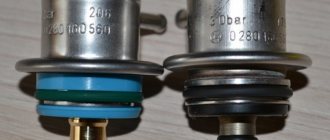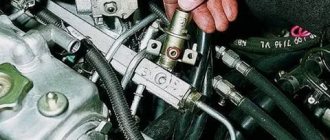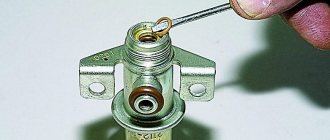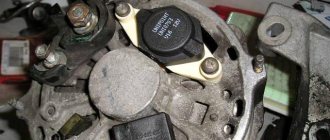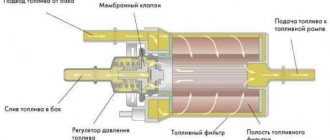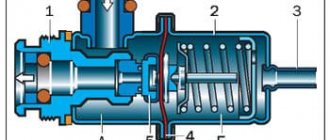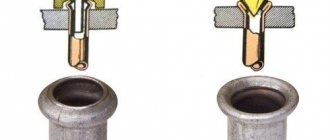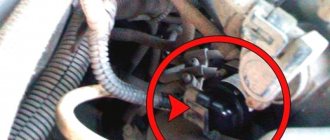The fuel pressure regulator is an element of the injection engine power system, which allows you to maintain the required fuel pressure in the fuel injectors at different operating modes of the internal combustion engine. In other words, the overall performance of the injectors and the stability of the engine depend on the serviceability of the fuel pressure regulator (FPR).
We also recommend reading the article on how to clean injection nozzles yourself. In this article you will learn about various methods for cleaning injectors with your own hands.
Considering that the pressure regulator is actually a diaphragm valve, failure of this element can greatly affect the operation of the engine. In this article we will look at the principle of operation of the regulator, highlight the main signs of its malfunction, and also talk about how to check the fuel pressure regulator.
Fuel pressure control
The fuel pressure regulator (aka FPR) is designed to maintain constant pressure in the fuel injector. On one side, a spring with a special valve exerts pressure on it, and on the other, gasoline. The bottom line is that it maintains the same pressure under different engine operating conditions, and when the load is removed, it sends an excess amount of gasoline back to the tank, thereby saving fuel and maintaining pressure in the fuel supply system.
The most common fuel regulator malfunctions
- The pressure is gone . This is why gasoline is pumped back into the gas tank and the car does not start.
- The valve becomes clogged and gasoline is difficult to flow through. As a result, gasoline begins to leak from almost everywhere. This is the most important malfunction of the pressure regulator. As soon as gasoline consumption increases sharply, you can immediately change the regulator.
- This reason is a development of the second. The valve becomes completely clogged and gasoline does not enter the fuel supply system.
- Uneven pressure . Usually caused by a stuck valve. Because of this, the car moves unevenly: it jerks or even stalls.
However, not all faults point to the valve, therefore, it is necessary, first of all, to learn how to check the pressure regulator, and then draw the appropriate conclusions.
Causes of RDP malfunctions
Most often, the valve fails due to sagging of the spring, which begins to wedge. This is caused by natural wear and tear of the metal and, unfortunately, there is no escape from it. This can also be caused by the car being idle for a long time. To prevent this from happening, the car needs to be driven more often.
The second reason why the regulator fails is low-quality fuel. Many gas stations dilute fuel with water to increase volume and make more money. Therefore, refuel only at trusted gas stations.
How to check the fuel pressure regulator of a VAZ 2110
When the first cars equipped with carburetors appeared on the VAZ assembly line, the pressure in the system was measured using the jet density created by disconnecting the valve or pinching it. However, after the market began to fill with injection cars, this method became very outdated.
Currently, pressure is measured using a pressure gauge, which is connected between the hose and the fitting. The vacuum hose must be removed. The measurement is made at idle and the measurement result is individual for each pressure regulator. Typically, the pressure rating can be found on the body of the product.
During the measurement process, after disconnecting the vacuum hose, the pressure should increase by 0.5 bar and if this does not happen, then the vacuum hose must be replaced.
Replacing the fuel pressure regulator VAZ 2110
As soon as gasoline consumption increases sharply, you can safely begin replacing the RTD. After replacing it, the pressure will normalize and gasoline will flow into the fuel supply system as before. At the same time, fuel consumption will quickly decrease.
Replacement procedure
1. Open the hood and disconnect the battery terminal. This is necessary in order to avoid accidental short circuits, which can damage devices or cause a fuel fire. Then, it is necessary to disconnect the special fitting plug to control the pressure at the end of the ramp. After removing it, a rubber O-ring will be visible inside. If it is in very poor condition, replace it immediately.
2. Using a metal protective cap, unscrew the spool from the fitting.
3. After performing the pressure gauge measurements described above, reduce the system pressure. Unscrew the two nuts that secure the fuel pipe to the pressure regulator.
4. Also unscrew the two bolts that secure the regulator to the fuel rail.
5. Slowly remove the fuel pressure regulator fitting from the rail and remove it from the fuel pipe.
6. Mount the new regulator and reassemble the components in the reverse order. It is recommended to lubricate all O-rings with gasoline. Even those rings that have lost their elasticity during use can be replaced.
That's all. This completes the replacement of the VAZ 2110 fuel pressure regulator. This operation is quite complex and involves working with gasoline-containing units. It is not recommended to carry out this work if you are feeling unwell: headache, dizziness, as this may jeopardize your health. It is best to do the work on another day or entrust all this to specialists from a car service station.
Replacing the RTD
Replacement is carried out in the following order:
- It is necessary to reduce the pressure in the fuel system, then unscrew the nut securing the fuel pipe to the RTD;
- Unscrew the bolt with a 10mm wrench securing the oil level indicator guide tube and remove it;
- Unscrew the bolts securing the RDI to the ramp;
- Remove the fitting from the fuel rail, remove the RTD;
- When installing a new regulator, experienced car owners advise lubricating the O-rings with gasoline.
In the future, do not forget to look at the fuel level sensor. If a large flow rate is detected, you may suspect that the replacement was not carried out entirely correctly, and it needs to be carried out more carefully.
Source
Where is the fuel pressure regulator located on the 16 valve VAZ-2112
In order for the operation of the entire engine to be stable, it is necessary to maintain a stable and constant fuel pressure in the VAZ-2112 fuel system. This is exactly what the fuel pressure regulator (fuel pressure regulator) is designed to do, and when this device is faulty, the engine will not be able to function properly.
The video shows an example of replacing the fuel pressure regulator on a VAZ of the SAMARA family; for 2112 everything is similar:
Where is the fuel pressure regulator located?
The fuel pressure regulator on the VAZ-2112 is located directly on the injector ramp and is a special diaphragm valve connected to the fuel supply system, drain line and air tube, which is supplied from the intake manifold. If desired, dismantling it is not difficult.
Unscrew the fastenings of the fuel supply regulator and remove it
Operating principle of RTD
The operating principle of the fuel pressure regulator is as follows:
- Fuel pressure acts on the sensor on one side, and on the other, air pressure and spring force, which is specially tuned to certain system parameters.
- When the engine is in good working order, its operating pressure is: 2.9–3.3 kgf/cm2 (284–325 kPa).
Signs of a malfunctioning fuel pressure regulator
The following malfunctions may be observed in the operation of the RTD:
- The regulator valve does not hold and fuel begins to leak , causing the pressure in the system to decrease. As a result of this problem, the engine does not have enough fuel, even when the speed is increased. As a result, the power drops, and to start the engine you have to turn it with the starter much longer. All this happens because the necessary pressure in the system simply cannot stay there.
- The valve does not work - for this reason, the fuel is not discharged back into the tank, and the pressure in the system is constantly increasing. As a result, all the fuel enters the combustion chamber, but does not have time to burn out. What causes excessive consumption and insufficient fuel.
Signs of breakdown
If for some reason the fuel pressure regulator does not perform its functions, then this can be understood by the following signs:
- The engine's operation has become unstable, it may begin to stall when idling, although it would seem that the fuel level is sufficient and all systems are in working order;
- The crankshaft at idle speed has increased or, conversely, decreased speed;
- The engine, as they say, “loses throttle response”;
- While driving, dips and jerks occur in a running engine;
- Gasoline consumption increases compared to what it was before;
- The content of CO and CH in the exhaust increases;
- The engine starts with difficulty. Although this property does not always appear.
Old style fuel pressure regulator with engine capacity 1.5 liters
- Manufacturer: RES
- 0 reviews
- Description
- Characteristics
- Video
- Reviews 0 ? '(' + product.reviewsCount +')' : »>>
Dear customers, in order to avoid errors when sending a fuel pressure regulator for VAZ, Lada with an engine capacity of 1.5 liters, old model, in the “Comment” line indicate the engine size, model of your car, year of manufacture.
Any breakdown is not the end of the world, but a completely solvable problem. For an injection engine to operate, a certain pressure must be maintained in the fuel system. This task is performed by the RDT 300 pressure regulator. A faulty device will not allow the engine to operate normally and must be replaced.
On VAZ and LADA vehicles, the RDT 300 fuel pressure regulator ensures the functioning of the fuel injection system in normal mode. With its help, the optimal pressure value is maintained in the fuel rail, which is necessary for the gasoline to be in a state of fog. Due to the pressure, which is higher than atmospheric, the air-fuel mixture is injected into the combustion chambers. If the regulator fails, the entire injection system does not work correctly and serious problems in the functioning of the engine are possible.
The fuel pressure regulator (RDT 300) maintains gasoline pressure in the fuel system at a constant certain level, regardless of engine operation. It is installed in the injector rail and is a diaphragm valve connected to the fuel supply channel to the injectors, the drain line and the air tube supplied from the intake manifold.
The RDT 300 valve is affected by fuel pressure, on the one hand, and, on the other, by air pressure in the tube and spring force, adjusted to certain operating parameters in the system. When the engine is running, a serviceable RTD maintains the following indicators in the system: 2.9–3.3 kgf/cm2 (284–325 kPa).
Among the most common device breakdowns are the following:
- The valve does not hold - fuel begins to circulate freely throughout the fuel system, the pressure in which decreases because of this. As a result, the engine does not have enough fuel when the speed increases, and its power decreases; The pressure in the system should not change after stopping the engine, but since the valve is not able to hold it, when starting the engine, you have to work with the starter for a long time to create the required pressure.
— A completely inoperative valve - fuel is not discharged into the tank, and because of this, the pressure in the system increases. As a result, the amount of fuel supplied to the combustion chambers through the injectors increases - there is overconsumption and incomplete combustion of gasoline.
Signs of a faulty RTD are the following engine operation:
- stalls at idle;
- cannot develop full power;
— the crankshaft rotates at idle speed with a reduced or increased frequency;
— dips and jerks while the machine is moving;
- difficult starting - not always;
— the content of CO and CH in the exhaust gases significantly exceeds the permissible standards;
To check the operation of the RTD 300, you will need a 24mm wrench, a 5mm hexagon and a pressure gauge (for example, a tire gauge):
— Unscrew the plug of the pressure control fitting on the end surface of the injector ramp;
— Using the metal tire valve cap, unscrew the spool valve from the fitting.
— Connect the pressure gauge to the fitting through a hose, the ends of which are secured with clamps, and start the engine.
Check the pressure - disconnect the vacuum hose from the RDT 300.
The pressure gauge readings should increase by 0.2–0.7 kgf/cm2 (20–70 kPa). Otherwise, the RTD must be replaced.
Replacing the RDT 300 regulator:
- release pressure in the fuel line;
— unscrew the nut securing the fuel return pipe to the RDT 300;
— unscrew the 2 bolts securing the RTD to the injector ramp;
— carefully remove the RTD fitting from the ramp hole;
— disconnect the fuel pipe from the RTD and remove it;
— install the new RTD 300 in the reverse order, first moistening the rubber sealing cuffs with gasoline (replace inelastic and torn rings).
Other article numbers of the product and its analogues in the catalogues: 21120116001000, 211201160010-01, RDT 300.
VAZ 2104-05-07, VAZ 2108-09-099, VAZ 2110-11-12, VAZ 2113-14-15 injection.
Any breakdown is not the end of the world, but a completely solvable problem!
How to independently replace the fuel pressure regulator with an engine capacity of 1.5 liters, an old model in a VAZ, LADA car of their modifications?
How to identify a problem with the idle air regulator (IAC) on a VAZ or Lada car of their modifications?
How to independently replace the idle air regulator (IAC) in a VAZ, LADA car of their modifications?
AvtoAzbuka online store, repair costs will be minimal.
Just COMPARE and BE SURE.
Don't forget to share the information you find with your friends and acquaintances, because they may also need it - just click one of the social networking buttons located above.
Symptoms of a problem
Before moving directly to the process of replacing the regulator, you need to mention the signs of its malfunction.
The main one is problems in the operation of the valve, especially when the valve does not hold well, i.e. fuel circulates freely. This in turn provokes a decrease in pressure. As a result, the engine power decreases, because it does not have enough fuel to increase speed. When you turn on the engine, it becomes necessary to work for a long time with the starter (i.e., a device that spins the engine shaft in order to start it) in order to create the required pressure. If the valve is completely inoperative, fuel stops being discharged into the tank. This provokes an increase in pressure. As a result, there is excessive consumption of gasoline, as well as incomplete combustion.
In addition, there are other signs indicating a malfunction of the RTD in the VAZ 2110:
- the engine stalls at idle;
- the motor does not work at full power;
- unstable engine operation;
- the content of CO (carbon monoxide) and CH (methane) significantly exceeds the established standards;
- jerking while driving.
Fuel pressure regulators Lada
Automotive service technicians and home-grown car enthusiasts are familiar with countless elements of vehicle measurement, thanks to a measurement system invented and implemented by French engineers in 1790 called the metric system.
Creating and repairing a car requires mastery of all measurement techniques. It is necessary to understand and distinguish between concepts such as volume, length, time, interval and much more. In cars, tolerances are measured in thousandths; today, in many cases this is not enough and must be measured in tens of thousandths for optimal and efficient operation of all components and mechanisms.
The tools that are most needed today in measuring any element are:
- high-quality set of micrometers;
- set of pressure gauges;
- spring testers;
- surface roughness testers;
- vacuum testers;
- and this is just the beginning.
The car's fuel system itself can be divided into three main elements: power, pressure and return. The high pressure pump is the starting point of the system. Pumps may differ in design, but the basic principle is the same. Next come the fuel lines from the fuel tank and the filter. The fuel is kept under pressure in the system by a pump. The fuel line is connected to the fuel rail with high pressure steel lines emanating from it to power the individual injectors.
Having a fuel pressure regulator helps reduce fuel temperature, reduces pump load, reduces parasitic load on the engine, reducing emissions.
In case of increased pressure in the common line, two options are possible to resolve the issue. One is known as a mechanical pressure limiter, placed at the end of the common fuel line and consisting of a spring-loaded plunger. When excess pressure in the rail is reached, the valve opens and fuel is discharged back into the tank. Another version is controlled electronically by a control unit (ECU). The fuel pressure sensor on the rail informs the control unit about the pressure inside the system. The ECU regulates the required amount of pressure to achieve maximum output of the power unit. Due to the faster response time, the regulator is able to more quickly relieve excess pressure in the line. The pressure control device is installed on the ramp supplying the injectors. On systems without fuel return to the tank, the regulator is part of the fuel pump assembly inside the fuel tank, reducing fuel pressure when the engine is at low load and increasing it when the engine accelerates.
The main task of the fuel pressure regulator on a VAZ is to maintain uniform and constant pressure from approximately 0.7 bar to 5.5 bar. Low fuel pressure will lead to deterioration in the performance of the power unit, possible misfires and difficult engine starting. Low fuel pressure can be caused by a weak fuel pump (wear), a restriction in the fuel line (kinked, jammed line), a clogged fuel filter, or a leaking pressure regulator that should be within vehicle specifications. The check can be done using a pressure gauge connected to a valve on the fuel rail or to the fuel line.
Note: Power units are very sensitive to fuel injection pressure. If the pressure in the rail is detected, even a few bar less than in the specification, negative consequences with startup and uninterrupted operation are possible. Each powertrain is different in design and performance, so always pay attention to the pressure specification when identifying fuel problems.
With increased fuel pressure, the power unit runs on a rich mixture, which leads to increased fuel consumption and carbon monoxide (CO) emissions. A power unit running on rich fuel experiences problems with smooth idling and surging.
If the fuel pressure is low, the power unit may not start and perform poorly. Low fuel pressure leans the mixture, causing misfires, rough idling and poor acceleration.
Checking the fuel pressure begins by attaching a pressure gauge to the system. To fully analyze and assess the condition of the regulator, a number of different checks are carried out in a static idle state, with the engine turned off, for the presence of residual pressure, maximum up to the reset point and the volume of supplied fuel. The regulator is checked for pressure drop to check for injector leakage. By installing a test pressure gauge on the ramp, you can check the pressure while the engine is running.
Attention: Before connecting the pressure gauge, the pressure in the fuel supply system must be relieved.
With the engine off, but with the key and fuel pump energized, the pressure should be held steadily at a fixed value. If the pressure readings are below normal, the cause may be a weak pump, a blockage in the line, filter, or low voltage on the pump.
The real job of the fuel pressure regulator is to work with turbocharged units and properly sized injectors. The regulation system fully justifies its use with units up to 500 hp. Most passenger cars do not require regulators and this is a waste of time and money for quiet small cars. But if you have a powerful racing engine using methanol that requires a high fuel flow rate, the regulator must be present.
Why does the device fail?
Fuel pipe
The regulator stops working normally mainly for two reasons.
- Low-grade fuel is used, which contains a large amount of water.
- The car sits idle for a long time, is not used and does not start even for the purpose of prevention.
Fuel Rail - Operating Pressure Check
The operation is shown on engine 21114. Checking the fuel pressure on other engines is performed in the same way.
Before performing the operation, read the safety rules when servicing and repairing the power system (see “Safety precautions when servicing and repairing the power system”).
To perform the work you will need a special pressure gauge.
1. We prepare the car for work (see “Preparing the car for maintenance and repair”).
2. On engines models 2112, 21114 and 21124
remove the decorative trim (see “Decorative engine trim - removal and installation”).
3. Unscrew the protective cap of the fuel rail diagnostic fitting.
4. Connect the tip of the pressure gauge hose to the fuel rail fitting.
5. 14 mm
wrap the end of the hose.
If necessary, the pressure in the fuel rail can be measured with a homemade device, made from a pressure gauge from a foot pump. Before connecting such a pressure gauge, the fuel pressure must be relieved (see “Fuel Line - Pressure Relief”). After this, unscrew the spool from the fuel rail fitting. This can be done with a metal wheel valve cap. To connect the pressure gauge to the fuel rail fitting, use a piece of gas-resistant hose of suitable diameter. The ends of the hoses must be securely secured with clamps.
6. Turn on the ignition. The fuel pump will run for a few seconds. After waiting until the pump stops working, turn off the ignition.
7. To remove air from the pressure gauge, lower the end of the drain tube into a small container, unscrew the bleeder fitting of the pressure gauge 1/3-1/2 turn and release excess gasoline pressure from the fuel rail. This will remove air from the pressure gauge hose.
8. Screw in the bleeder fitting until it stops.
We start the engine and measure the operating pressure in the fuel rail at different crankshaft speeds. For a working engine it should be within the following limits: for engines 2111 and 2112
— 284-325 kPa (2.8-3.2 bar);
for engines 21114 and 21124
- 378-390 kPa (3.8-3.9 bar).
On 16-valve engines, the operation is as follows:
On engines 2111 and 2112, disconnect the rubber hose from the pressure regulator pipe. If after this the fuel pressure does not increase by more than 0.2 bar, then the regulator is faulty.
9. Turn off the ignition.
10. Having lowered the end of the tube into the container, open the fitting and relieve pressure from the fuel line.
11. Disconnect the pressure gauge from the diagnostic fitting of the fuel rail.
12. Screw the protective cap onto the fuel rail fitting.
Recommendation.
If the operating pressure in the fuel rail is unstable or higher than normal, then the fuel pressure regulator is faulty (see “Fuel module of engines 21114 and 21124 (1.6i) - replacing the fuel pressure regulator", “Fuel rail of engine 2111 (1.5i 8V) - replacing the fuel pressure regulator”, or “Fuel rail of engine 2112 (1.5i 16V) - removal, disassembly, assembly and installation”). Low pressure (less than normal) can also be caused by a malfunctioning regulator. The fuel pump strainer may be clogged or the fuel pump may not be producing the required pressure. To clean the strainer, you need to remove the fuel module (see "2111 and 2112 (1.5i) Engines Fuel Module - Removal and Installation", or "21114 and 21124 (1.6i) Engines Fuel Module - Removal and Installation".
How to check the RTD of a VAZ 2110?
If you want to check the fuel pressure regulator 2110, you must first unscrew the special plug that closes the fitting for checking the pressure.
You should look for the fitting on the ramp block, from the end. After you have unscrewed the plug, you need to unscrew the spool from the fitting. Use the back of a metal tire cap for this.
After the completed operations, attach a pressure gauge to the fitting using a hose. You can take a regular pressure gauge that you use to measure tire pressure. Secure the ends of the hose with clamps. Now you can start checking - turn on the engine. We continue to check the pressure - it is necessary to disconnect the vacuum hose from the fuel pressure regulator. After removing the hose, the correct pressure gauge readings should be in the range of 0.2 - 0.7 cm 2. Other data indicates the need to replace the RTD.
Fuel pressure regulator sport VAZ 3.8 bar
- Engine Crankshaft
- Flywheel
- VAZ cylinder head
- Sports camshafts
- Sport timing valves
- Cylinder head components
- Belts | Timing gears
- Gaskets | Oil seals
- Intake system
- Throttle valve
- Clubturbo pistons
- TDMK pistons
- Federal Mogul pistons
- Piston rings
- Connecting rods
- Engine mounts
- Inserts for VAZ engines
- ACL earbuds
- Oil catchers
- Oil crankcase
- Oil pump
- Miscellaneous
- Turbo Turbo kit
- Turbochargers
- Turbo manifold
- Bypass valves
- Westgates
- Intercooler for VAZ
- Intercooler kit
- Piping kit (air ducts)
- Turbo parts
- Adapters for installing an oil cooler | sensors
- Straight pipes
- Blocking
- Vacuum booster
- Clubturbo suspension
- Silencers for VAZ
- Ignition system
- Filler necks
- Moto kits Turbo
- Adapters for installing sports steering wheels
- Keychains
- Bumpers tuning for VAZ
- Hoses | tubes
- Thermal insulation
- home
- Catalog
- Fuel system
- Fuel pressure regulators
- Fuel pressure regulator sport VAZ 3.8 bar
Troubleshooting
To find problems, we suggest you use the appropriate methods.
- Pump fuel into the system, turn off the ignition and monitor the behavior of the pressure gauge. In a normal situation, the pressure drops to 0.7 Bar and stops at this level. If the regulator fails, the pressure gauge will tend to zero. The problem may lie in the device itself, or in the fuel pump motor valve.
- Increase the engine speed to 3 thousand and again look at the pressure gauge readings. If the arrow points down, the fuel pump is broken. It needs to be replaced.
- If the pump takes a long time to build up pressure, the problem lies in the filter or mesh of the tank, which is clogged with debris.
